
An Ecclesiastial award is an official award, honor or privilege presented by ecclesiastical authority.

An Ecclesiastial award is an official award, honor or privilege presented by ecclesiastical authority.
In the Eastern Orthodox Church certain official awards and honours may be bestowed upon members of the clergy and laity. Such awards are bestowed either by the ruling bishop under whose jurisdiction the recipient resides, or—in the case of higher awards— by a synod of bishops.
When a bishop wishes to confer an ecclesiastical award or honor on a deacon or priest under his jurisdiction, this will normally be accomplished at the Little Entrance of the Divine Liturgy. At the end of the Third Antiphon (normally the Beatitudes), the procession with the Gospel Book will halt at the bishop's cathedra (episcopal throne). The clergyman who is to receive the award will be presented to the bishop, the protodeacon will remove the bishop's mitre, the bishop will lay his hand upon the head of the clergyman and say the prayer proper to that particular award. He will then confer the award and the people will exclaim, "Axios! Axios! Axios!" as an expression of their acknowledgment of the clergyman's worthiness for the award, similar to applause at a secular awards ceremony.
Awards differ according to the rank of the individual honored, and will vary among the ecclesiastical jurisdictions. Awards granted to bishops and the higher awards to priests are often reserved to begin conferred by a synod of bishops.
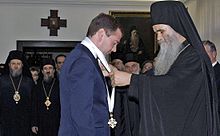
Some of these awards have their origin in the Byzantine court, others developed later. During the reign of Catherine the Great these awards came to be tied to the stipend which was paid to clergymen.
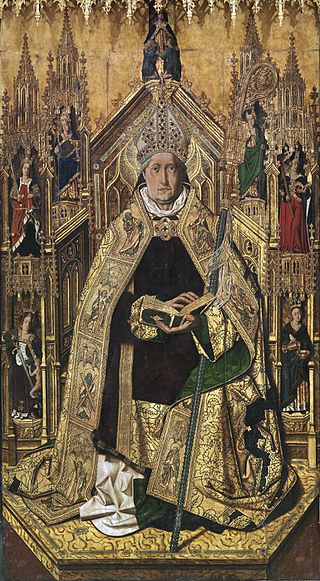
Abbot is an ecclesiastical title given to the head of an independent monastery for men in various Western Christian traditions. The name is derived from abba, the Syriac form of the Hebrew ab, and means "father". The female equivalent is abbess.
A bishop is an ordained member of the clergy who is entrusted with a position of authority and oversight in a religious institution. In Christianity, bishops are normally responsible for the governance and administration of dioceses. The role or office of the bishop is called episcopacy. Organizationally, several Christian denominations utilize ecclesiastical structures that call for the position of bishops, while other denominations have dispensed with this office, seeing it as a symbol of power. Bishops have also exercised political authority within their dioceses.
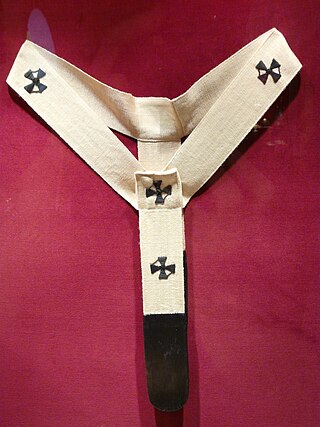
The pallium is an ecclesiastical vestment in the Catholic Church, originally peculiar to the Pope, but for many centuries bestowed by the Holy See upon metropolitans and primates as a symbol of their conferred jurisdictional authorities, and still remains a papal emblem.
An ecclesiastical court, also called court Christian or court spiritual, is any of certain courts having jurisdiction mainly in spiritual or religious matters. In the Middle Ages, these courts had much wider powers in many areas of Europe than before the development of nation states. They were experts in interpreting canon law, a basis of which was the Corpus Juris Civilis of Justinian, which is considered the source of the civil law legal tradition.
Defrocking, unfrocking, degradation, or laicization of clergy is the removal of their rights to exercise the functions of the ordained ministry. It may be grounded on criminal convictions, disciplinary problems, or disagreements over doctrine or dogma, but may also be done at their request for personal reasons, such as running for civil office, taking over a family business, declining health or old age, desire to marry against the rules for clergy in a particular church, or an unresolved dispute. The form of the procedure varies according to the Christian denomination concerned.
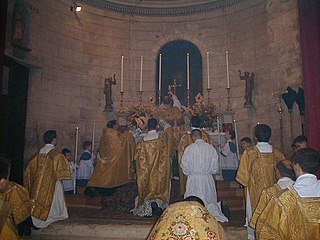
Vestments are liturgical garments and articles associated primarily with the Christian religion, especially by Eastern Churches, Catholics, Lutherans, and Anglicans. Many other groups also make use of liturgical garments; among the Reformed (Calvinist) Churches this was a point of controversy in the Protestant Reformation and sometimes since, in particular during the ritualist controversies in the Church of England in the 19th century.
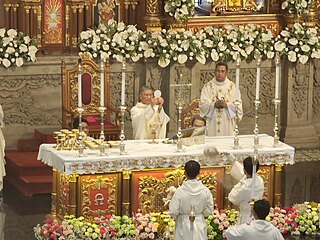
A Pontifical High Mass, also called Solemn Pontifical Mass, is a Solemn or High Mass celebrated by a bishop using certain prescribed ceremonies. Although in modern English the word "pontifical" is almost exclusively associated with the pope, any bishop may be properly called a pontiff. Thus, the celebrant of a Pontifical High Mass may be the pope, any bishop or any other prelate who is allowed to wear pontificals.
The hierarchy of the Catholic Church consists of its bishops, priests, and deacons. In the ecclesiological sense of the term, "hierarchy" strictly means the "holy ordering" of the church, the Body of Christ, so to respect the diversity of gifts and ministries necessary for genuine unity.

A pectoral cross or pectorale is a cross that is worn on the chest, usually suspended from the neck by a cord or chain. In ancient history and the Middle Ages, pectoral crosses were worn by both clergy and laity. By the Late Middle Ages, the pectoral cross came to be a special indicator of position worn by bishops. In the Roman Catholic Church, the wearing of a pectoral cross remains restricted to popes, cardinals, bishops and abbots. In Eastern Orthodox Church and Byzantine Catholic Churches that follow a Slavic Tradition, priests also wear pectoral crosses, while deacons and minor orders do not. The modern pectoral cross is relatively large, and is different from the small crosses worn on necklaces by many Christians. Most pectoral crosses are made of precious metals and some contain precious or semi-precious gems. Some contain a corpus like a crucifix while others use stylized designs and religious symbols.
Protodeacon derives from the Greek proto- meaning 'first' and diakonos, which is a standard ancient Greek word meaning "assistant", "servant", or "waiting-man". The word in English may refer to any of various clergy, depending upon the usage of the particular church in question.
A provost is a senior official in a number of Christian churches.
Incardination is the formal term in the Catholic Church for a clergyman being under a bishop or other ecclesiastical superior. It is also sometimes used to refer to laity who may transfer to another part of the church. Examples include transfers from the Western Latin Church to an Eastern Catholic Church or from a territorial diocese to one of the three personal ordinariates for former Anglicans.

Ecclesiastical heraldry refers to the use of heraldry within Christianity for dioceses, organisations and Christian clergy. Initially used to mark documents, ecclesiastical heraldry evolved as a system for identifying people and dioceses. It is most formalized within the Catholic Church, where most bishops, including the Pope, have a personal coat of arms. Clergy in Anglican, Lutheran, Eastern Catholic and Eastern Orthodox churches follow similar customs, as do institutions such as schools and dioceses.

In the Catholic Church, a bishop is an ordained minister who holds the fullness of the sacrament of holy orders and is responsible for teaching doctrine, governing Catholics in his jurisdiction, sanctifying the world and representing the Church. Catholics trace the origins of the office of bishop to the apostles, who it is believed were endowed with a special charism and office by the Holy Spirit at Pentecost. Catholics believe this special charism and office has been transmitted through an unbroken succession of bishops by the laying on of hands in the sacrament of holy orders.
The Holy Synod of the Coptic Orthodox Church of Alexandria is the highest Orthodox authority in the Coptic Orthodox Church. It formulates the rules and regulations regarding matters of the Church's organisation and faith.
The Synod of Baccanceld is said to have been held in Bapchild, Kent at the end of the seventh or beginning of the eighth century.
Pontifical vestments, also referred to as episcopal vestments or pontificals, are the liturgical vestments worn by bishops in the Catholic, Eastern Orthodox, Oriental Orthodox, Anglican, and some Lutheran churches, in addition to the usual priestly vestments for the celebration of the mass, other sacraments, sacramentals, and canonical hours. The pontifical vestments are only worn when celebrating or presiding over liturgical functions. As such, the garments should not be confused with choir dress, which are worn when attending liturgical functions but not celebrating or presiding.
Consecrations in Eastern Christianity can refer to either the Sacred Mystery (Sacrament) of Cheirotonea of a bishop, or the sanctification and solemn dedication of a church building. It can also be used to describe the change of the bread and wine into the Body and Blood of Christ at the Divine Liturgy. The Chrism used at Chrismation and the Antimension placed on the Holy Table are also said to be consecrated.
Presbyter is, in the Bible, a synonym for bishop (episkopos), referring to a leader in local church congregations. In modern Eastern Orthodox usage, it is distinct from bishop and synonymous with priest. Its literal meaning in Greek (presbyteros) is "elder".
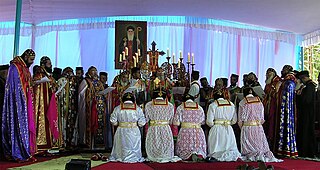
"Axios!" is an acclamation adopted by the early Oriental Orthodox Church, Eastern Orthodox church and Byzantine Eastern Catholic churches and made by the faithful at the ordination of bishops, priests and deacons. The acclamation may also be made when a bishop presents an ecclesiastical award to a clergyman during the Divine Liturgy.